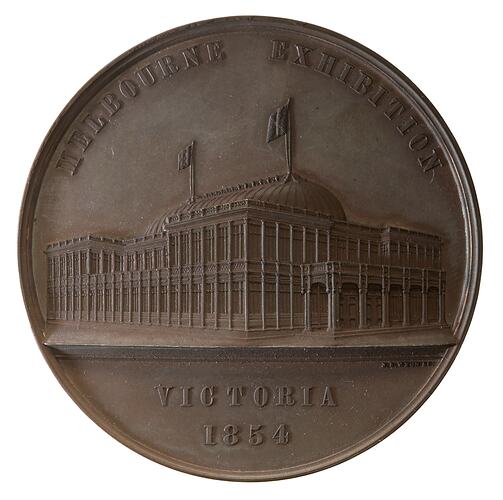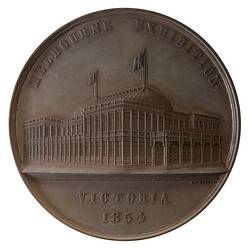John Hunter Kerr emigrated from Scotland at the age of 18 in 1839, and first took up land near Heidelberg, on the outskirts of Melbourne. The 1840s depression, which ruined many of Port Phillip's gentlemen squatters, left him in financial straits. He moved from his station, settling on a farm on the Yarra flats, and later returned to Scotland for two years. On his return to the colony in 1849, he purchased a property on the Loddon, which he renamed 'Fernyhurst'. This was a station of 89,000 acres, which he and his partner stocked with sheep and cattle. He sold meat to the diggers on the Korong goldfields, and was obviously a person of some importance in the local community - he was appointed a magistrate in 1854. However, he was an unsuccessful squatter. 'Bad seasons and adverse circumstances' including the 'dissipation' of his partner were reasons given after Kerr's death for his failure. He was forced to sell 'Fernyhurst' in 1855, but stayed on the property, possibly as manager, until 1861.
Kerr anonymously wrote a volume of reminiscences that was published in 1872. The impression given in the autobiography is of a man with considerable enthusiasm for living and a great curiosity in his new environment. He was interested in his First Peoples neighbours, both in Heidelberg and at the Loddon, and claimed to have been 'always on very friendly terms' with them. He described accompanying them on hunting expeditions for kangaroo, possum and wild turkey, and wrote of the patient perseverance and trustworthiness of the Indigenous people he knew. While he shared the contemporary belief that 'the doom of their race was fixed, and that, in obedience to the mysterious decree of Providence, they were passing away to give place to a superior race', he was interested to record the transition from what he called 'the savage pur et simple' to a people 'undergoing a great change of habits and character since their intercourse with white men.' A few years before he arrived at 'Fernyhurst', the Murray and Loddon tribes were already recorded as having declined in population by 10-12%.
John Kerr's station house was close to a First Peoples camp, and he writes about visits to and from the camp. He describes for example, his attendance at the burial of a chief, and reports conversations with his 'quiet inoffensive neighbours' about their marriage customs, their experience of missions, and the visits to Melbourne of some tribal leaders. Kerr was one of the earliest photographers to capture an image of First Peoples. As he described it, 'when their first shyness was overcome they were never weary of sitting in any attitude, and laughed with childish glee at the results'. Soon after his arrival at the station, Kerr persuaded the local people to stage a corroboree during the day for him, giving them 'a considerable present' to do so. He was told that women could not see a corroboree in daylight so, to add verisimilitude, he arranged for three young men, wrapped in their skins, to pose as the audience. The resulting photograph is perhaps the earliest ever taken of a corroboree.
Kerr's other photographs include images of First Peoples men in possum skin cloaks with traditional weapons, and a 'young half-caste boy on possum rug' with his toys: bull rushes, a small shield and playing sticks. He knew some of the women and children of the camp as well. A few years after settling at 'Fernyhurst', he drew a portrait of 'Queen Jerrybung' or 'Jellibung', an elderly matriarch of the tribe, and a lithograph was later made of his drawing. A photograph taken in 1849 of his station hut and yard includes a servant who appears to be a First Peoples woman, dressed in European clothing, including a dress, bonnet and a large apron. Kerr did not pose his neighbours in traditional dress against a 'timeless' background of the Australian bush, or against the backdrop of their own homes. Instead, he posed them against the walls of a building made of dressed stringybark, which was possibly his own first home or the separate building provided as accommodation for his employees. In this way he was portraying the Indigenous people 'coming in', moving into the station complex and not remaining on the edge. His photography also hinted at the changes in First Peoples culture wrought by the coming of Europeans. One of his most striking photographs shows a young man in a possum skin cloak who stands proudly against the backdrop of a white sheet pinned to the stringybark wall; he holds a European flintlock musket and aims it with authority away from the photographer into the distance.
In 1854, Kerr was about to be appointed a local magistrate, and was thinking of joining the Melbourne Club. It was not yet apparent that he had been living beyond his means, and was soon to face bankruptcy. In July that year, Kerr responded with enthusiasm when he learnt that a committee of public men in Bendigo was calling for 'specimens of the industry and resources of the colony of Victoria' to be collected and forwarded for a display in a new exhibition building in the town. A central committee in Melbourne had appealed to local authorities to gather material for an exhibition in the capital city, but the Bendigo authorities, confident and wealthy, considered that they could have their own exhibition first. They called for material that would be displayed first in Bendigo, then in Melbourne, and that would then be forwarded to Paris for the Exposition Universelle planned for 1855. Kerr's autobiography is silent on his involvement in these three exhibitions, and we can only surmise why he became involved. But he was no stranger to exhibitions: in January 1851 he had won a gold medal for 'the best colonial thoroughbred' in an exhibition organised by the Victorian Industrial Society. He was quick to respond to the Bendigo Exhibition Committee's request, gathering and forwarding to Bendigo a wide range of material for display.
The Bendigo Exhibition (also known as the Sandhurst Exhibition), 'the first Exhibition of Industry held in Australia', was held only three years after the enormously successful Exhibition of Industry of the Nations at the Crystal Palace in London in 1851. Victoria had not been separately represented at the London exhibition, and the colonists wanted to ensure that they were properly represented at the next international exhibition, so that they could make a significant contribution to the international stage.
The collection of First Peoples material culture that John Kerr submitted under his name for the Sandhurst Exhibition was impressive in its variety and extent. As well as tools, shields, waddies, boomerangs, 'native tomahawks', spears and spear throwers it included 'opossum skins worked by Aborigines'; an emu skin; the 'skin of an opossum on bark'; some 'native boys' play sticks'; and some examples of women's work, particularly 'native grass wrought by lubras' and 'a kangaroo rat bag'. In addition, he displayed three items of ceremonial significance: 'emu feathers used in corrobberys'; 'kangaroo rat skins, used in corrobberys'; and a large curved piece of bark in the shape of an emu, decorated with white ochre lines, which he later told collector R.E. Johns that he had seen used in corroborees. To round off the collection, he exhibited at least two 'native drawings on bark'. One of these shows a kangaroo and other animals being hunted; the other, now at Kew, depicts First Peoples dancers in corroboree wearing emu feather head-dresses. Kerr also contributed a collection of raw materials to the Bendigo Exhibition, displaying 'specimens of iron ore, gum-vines, pine-gum, lime, salt, gypsum and smelted iron ore,' and 'woollen gloves and socks' made on his station from 'rough wool'.
Kerr's collection of Aboriginal material has received little attention from historians, probably because so few pieces from it are known to have survived. Yet he was the first to present a systematic display of Aboriginal material to a wide public in Victoria. His collection is also notable because it included material from women and children, as well as men. He may have photographed at least some of the collection at 'Fernyhurst' before he took it to Bendigo. A lithograph of a photograph showing boomerangs, spear shields, parrying shields, two types of spears, spear-throwers, weet-weet or play sticks, clubs, an opossum skin rug and fibre rope, displayed against the wall of a bark shed, was published as the frontispiece of his book in 1872.
When the Bendigo Exhibition opened in September 1854, the press reports described Kerr's exhibit as 'an excellent collection of weapons and various articles used by the aborigines'. The collection included at least one example of a work-in-progress: an opossum skin pinned out on bark to show how the skins were prepared before being made into rugs. At the Sandhurst Exhibition, Kerr's exhibit of Indigenous industry received a silver medal. Interestingly, though, the citation was for a display of 'native weapons'. Despite the evidence in front of them for an Indigenous material culture that was much wider and more complex than merely instruments of war and tools for the hunt, the judges appear to have interpreted the collection through eyes which noticed and recognised only the weapons. When the collection was moved down to Melbourne in October 1854 and displayed in the new Exhibition Building on the corner of William and Latrobe Streets, it was placed on the mezzanine near the picture gallery, and described as 'a most interesting and elaborate collection of aboriginal implements and articles of clothing'.
Kerr's collections, along with samples of Victorian gold, wool and timber, and specimens of the mammals, birds and plants of the region, were shipped to London and thence to Paris in the care of Special Commissioner Edward Bell, who was to set up the Victorian Court as part of the British Court in the new exhibition buildings along the Champs-Elyses. Bell was charged with the care of twenty packages from Victoria, including a valuable collection of Victorian gold nuggets. He had a horrible trip on the Argo: the voyage took over two months; the impressive display case that had been provided to house the Victorian gold was too large to fit in the hold and obstructed promenaders on the deck; and he seemed to quarrel with most people on board. When he arrived in Paris, he discovered that no formal application had been made by the Victorians for space in the Exhibition. He succeeded in obtaining a very prominent position for the case of gold, but the other material, including the First Peoples exhibits, was placed out of the mainstream in a hot, glass-roofed temporary annexe. When Bell wrote his report to the Chief Secretary in June 1855, he was afraid that not many people would see the Victorian exhibits.
References:
Willis, Elizabeth (2003). 'Exhibiting Aboriginal Industry: A Story Behind a 'Re-Discovered' Bark Drawing From Victoria'. Aboriginal History, Volume 27, pp. 39-58.
More Information
-
Keywords
Medals, Farmers, Aboriginal peoples (Australians), photographers
-
Localities
-
Authors
-
Article types

